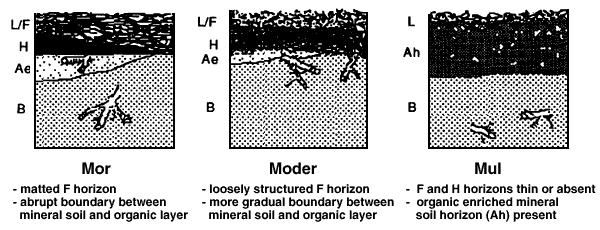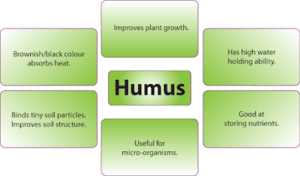Difference between revisions of "Humus"
| Line 6: | Line 6: | ||
| − | Humus is a a non living organic matter in soil that is derived from microbial decomposition of plant and animal substances. Humus is dark colored and consists of approximately 60% carbon, 6% nitrogen and small amounts of sulfur and phosphorus. In agricultural terms, humus can be described as well aged compost. Organic matter decomposes molecules into smaller molecules by microorganisms in the soil. Most of the chemicals in this organic matter can be extracted by microorganisms and can be shared with other beings within the soil. Humus has a wide variety of decay (ex. peatmoss, gradd, leaf compost, wood chips, decaryed sawdust, garden waste, etc). | + | Humus is a a non living organic matter in soil that is derived from microbial decomposition of plant and animal substances. [6] Humus is dark colored and consists of approximately 60% carbon, 6% nitrogen and small amounts of sulfur and phosphorus. In agricultural terms, humus can be described as well aged compost. Organic matter decomposes molecules into smaller molecules by microorganisms in the soil. Most of the chemicals in this organic matter can be extracted by microorganisms and can be shared with other beings within the soil. Humus has a wide variety of decay (ex. peatmoss, gradd, leaf compost, wood chips, decaryed sawdust, garden waste, etc). [3] |
| Line 16: | Line 16: | ||
'''Mor''' | '''Mor''' | ||
| − | Mor is generally found in coniferous forests or mixed-wood forests. it is also associated with acidic conditions. Mor comes from decomposing organic matter that lies on the surface of the soil. Fungi, earthworms, and small arthropods are some common organisms that decay into mor. Mor usually contains a low mineral content. The biological activity is relatively low, preventing decomposition of the organic matter. Mor has a slow transformation and accumulation process of plant residue. | + | Mor is generally found in coniferous forests or mixed-wood forests. it is also associated with acidic conditions. Mor comes from decomposing organic matter that lies on the surface of the soil. Fungi, earthworms, and small arthropods are some common organisms that decay into mor. Mor usually contains a low mineral content. The biological activity is relatively low, preventing decomposition of the organic matter. Mor has a slow transformation and accumulation process of plant residue. [4] |
'''Moder''' | '''Moder''' | ||
| − | Moder is the transitional form of humus. it lies between mull and moder. This type of humus is moderately humified and has characteristics of both mor and mull. Moder can be found where mor or mull are not generally favorable. | + | Moder is the transitional form of humus. it lies between mull and moder. This type of humus is moderately humified and has characteristics of both mor and mull. Moder can be found where mor or mull are not generally favorable. [5] |
'''Mull''' | '''Mull''' | ||
| − | Mull can be found in hardwood forests, deciduous forests, or grasslands in warm, humic climates. Unlike mor, the pH in this humus formation is much higher and larger insects are more abundant. mull is subject to rapid decomposition and is well mixed with minerals | + | Mull can be found in hardwood forests, deciduous forests, or grasslands in warm, humic climates. Unlike mor, the pH in this humus formation is much higher and larger insects are more abundant. mull is subject to rapid decomposition and is well mixed with minerals [5] |
[[File:mor_moder_mull_picture.gif]] | [[File:mor_moder_mull_picture.gif]] | ||
| Line 33: | Line 33: | ||
| − | [[File:humusb.png|thumb|left]] Humus absorbs moisture, therefore it raises the temperature of the soil and can maintain its heat. This can prevent the roots of plants form frosting during cold weather events. Humus holds onto nutrients and can prevent them from leaching. Humus can absorb moisture which can help soil during dry weather events. Since humus can retain nutrients, this allows plants and organisms to thrive in the soil. Humus can protect the soil from extreme temperatures. It also plays a huge role in soil fertility. Humus's biochemical structure allows it to buffer excessive acid or alkaline soil conditions. This prevents toxic substances from entering the ecosystem. Humus also supports the growth of a very important organism called mycorrihizal fungi. This fungi has a symbiotic relationship with many plants and helps bind the soil particles together to form a sturdy soil structure. | + | [[File:humusb.png|thumb|left]] Humus absorbs moisture, therefore it raises the temperature of the soil and can maintain its heat. [1] This can prevent the roots of plants form frosting during cold weather events. Humus holds onto nutrients and can prevent them from leaching. Humus can absorb moisture which can help soil during dry weather events. Since humus can retain nutrients, this allows plants and organisms to thrive in the soil. Humus can protect the soil from extreme temperatures. It also plays a huge role in soil fertility. Humus's biochemical structure allows it to buffer excessive acid or alkaline soil conditions. This prevents toxic substances from entering the ecosystem. Humus also supports the growth of a very important organism called mycorrihizal fungi. This fungi has a symbiotic relationship with many plants and helps bind the soil particles together to form a sturdy soil structure. [2] |
| Line 50: | Line 50: | ||
5. (n.d.). Retrieved from http://forestfloor.soilweb.ca/definitions/humus-forms/ | 5. (n.d.). Retrieved from http://forestfloor.soilweb.ca/definitions/humus-forms/ | ||
| + | |||
| + | 6. National Geographic Society. (2012, October 09). Humus. Retrieved from https://www.nationalgeographic.org/encyclopedia/humus/ | ||
Revision as of 09:35, 9 May 2018
Humus is a type of soil created from decaying plants and organisms. Coined by a french soil scientist, Muller, the name is derived from the latin word "soil". Humus is difficult to describe and has yet to be fully understood.
Description
Humus is a a non living organic matter in soil that is derived from microbial decomposition of plant and animal substances. [6] Humus is dark colored and consists of approximately 60% carbon, 6% nitrogen and small amounts of sulfur and phosphorus. In agricultural terms, humus can be described as well aged compost. Organic matter decomposes molecules into smaller molecules by microorganisms in the soil. Most of the chemicals in this organic matter can be extracted by microorganisms and can be shared with other beings within the soil. Humus has a wide variety of decay (ex. peatmoss, gradd, leaf compost, wood chips, decaryed sawdust, garden waste, etc). [3]
Formations of humus
Mor
Mor is generally found in coniferous forests or mixed-wood forests. it is also associated with acidic conditions. Mor comes from decomposing organic matter that lies on the surface of the soil. Fungi, earthworms, and small arthropods are some common organisms that decay into mor. Mor usually contains a low mineral content. The biological activity is relatively low, preventing decomposition of the organic matter. Mor has a slow transformation and accumulation process of plant residue. [4]
Moder
Moder is the transitional form of humus. it lies between mull and moder. This type of humus is moderately humified and has characteristics of both mor and mull. Moder can be found where mor or mull are not generally favorable. [5]
Mull
Mull can be found in hardwood forests, deciduous forests, or grasslands in warm, humic climates. Unlike mor, the pH in this humus formation is much higher and larger insects are more abundant. mull is subject to rapid decomposition and is well mixed with minerals [5]
Benefits of Humus
Humus absorbs moisture, therefore it raises the temperature of the soil and can maintain its heat. [1] This can prevent the roots of plants form frosting during cold weather events. Humus holds onto nutrients and can prevent them from leaching. Humus can absorb moisture which can help soil during dry weather events. Since humus can retain nutrients, this allows plants and organisms to thrive in the soil. Humus can protect the soil from extreme temperatures. It also plays a huge role in soil fertility. Humus's biochemical structure allows it to buffer excessive acid or alkaline soil conditions. This prevents toxic substances from entering the ecosystem. Humus also supports the growth of a very important organism called mycorrihizal fungi. This fungi has a symbiotic relationship with many plants and helps bind the soil particles together to form a sturdy soil structure. [2]
References
1. Britannica, T. E. (2015, July 27). Humus. Retrieved from https://www.britannica.com/science/humus-soil-component
2. What Role Does Humus Play in Soil Fertility? (2018, March 15). Retrieved from https://greentumble.com/what-role-does-humus-play-in-soil-fertility/
3. What is humus? - the secrete to great soil. (2017, March 22). Retrieved from https://www.gardenmyths.com/what-is-humus/
4. (n.d.). Retrieved from http://karnet.up.wroc.pl/~weber/typy2.htm
5. (n.d.). Retrieved from http://forestfloor.soilweb.ca/definitions/humus-forms/
6. National Geographic Society. (2012, October 09). Humus. Retrieved from https://www.nationalgeographic.org/encyclopedia/humus/


